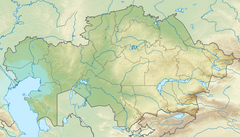Unionopterus
| Unionopterus | |
|---|---|

| |
| Type and only known specimen of U. anastasiae | |

| |
| Restoration of the carapace and first body segment of U. anastasiae | |
| Scientific classification | |
| Domain: | Eukaryota |
| Kingdom: | Animalia |
| Phylum: | Arthropoda |
| Subphylum: | Chelicerata |
| Order: | †Eurypterida |
| Superfamily: | †Adelophthalmoidea (?) |
| Family: | †Adelophthalmidae (?) |
| Genus: | †Unionopterus Chernyshev, 1948 |
| Type species | |
| †Unionopterus anastasiae Chernyshev, 1948
| |
Unionopterus is a
Unionopterus was described in 1948 after the discovery of its only known specimen in the Karaganda Formation of Kazakhstan (at that time part of the Soviet Union). This was one of the first discoveries of eurypterids in the Soviet Union and Carboniferous eurypterids in general. It was probably a swimming organism as well as other eurypterids, although not as good as its relatives.
There are numerous factors that have made Unionopterus a problematic genus for eurypterid researchers. It has been placed in the
Description
Unionopterus was a very small
The
Only four out of the six pairs of
History of research
Unionopterus is only known by an almost complete
Unionopterus has been considered as an enigmatic genus whose classification is highly uncertain. Because its only known specimen is probably lost and the original description by Chernyshev was not well-illustrated and in
Further, in 2005 the paleontologists Odd Erik Tetlie and Jason A. Dunlop suggested that the Belgian species Adelophthalmus dumonti could actually represent a species of Unionopterus due to similarities in the trapezoidal shape of the prosoma and the width of the marginal rim.[6] However, this was contested by Tetlie and Peter Van Roy a year later, following the re-analysis of a specimen of A. dumonti which showed that its carapace in fact had a parabolic (approximately U-shaped) shape and a narrow marginal rim, unlike that shown in its original description in 1917.[4]
Classification


Chernyshev classified Unionopterus as a member of the family Pterygotidae, mainly due to its great similarities to Hughmilleria (genus which he thought should have a separate clade), such as the prosoma and opisthosoma shape, position of the eyes, aerodynamic body, epimera, gradual narrowing of the body and shape of the swimming leg, among others.[1] Victor P. Tollerton, Jr. would classify it in 1989 in the family Adelophthalmidae,[5] but some later authors consider this classification uncertain.[4]
The
The following
| Diploperculata |
| |||||||||||||||||||||||||||||||||
Paleoecology
Like other forms with a similar body structure, it is likely that Unionopterus was a
See also
References
- ^ a b c d e f g Chernyshev, Boris I. (1948). "New representative of Merostomata from the Lower Carboniferous". State University of Kiev, Geological Collections. 2: 119–130.
- S2CID 91741388.
- ISBN 978-1125460221.
- ^ ISSN 0374-6291.
- ^ S2CID 46953627.
- ISSN 1860-1014.
- ^ Tetlie, Odd Erik (2004). Eurypterid phylogeny with remarks on the origin of arachnids (PhD). University of Bristol. pp. 1–344.

